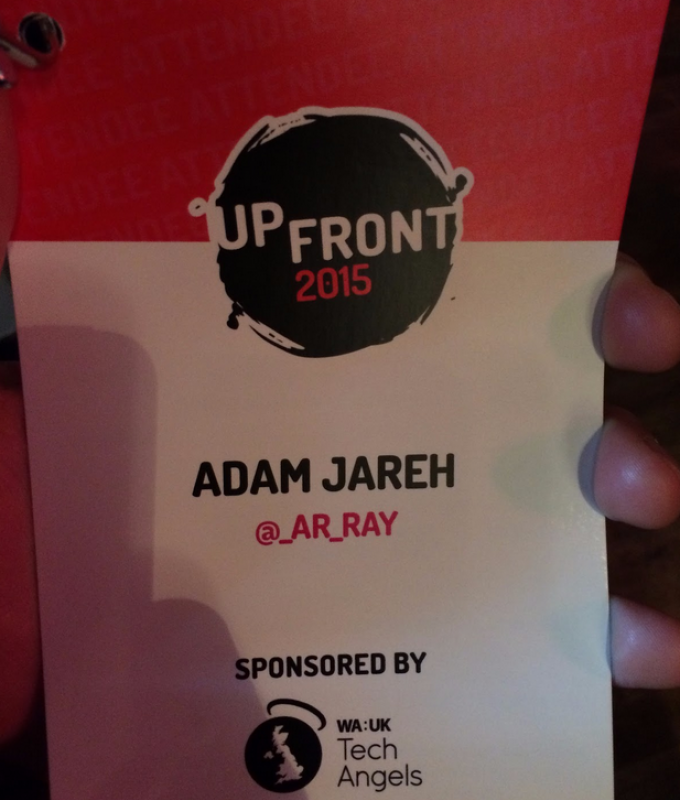Upfront Conference
Last week our team attended Upfront Conference 2015.
Upfront is “a front-end conference for anyone who makes for the web”. Held on the 19th of May at the Comedy Store in Manchester, the event welcomed speakers and attendees from all over the globe. After hearing the conference would be hosting some of the brightest minds in the industry, we were excited to find out more.
The speakers were Brad Frost, Alicia Sedlock, Richard Rutter, Soledad Penadés, Anna Debenham, Ben Foxhall, Dean Hume and Yesenia Perez-Cruz.
The event started with coffee and biscuits (and free t-shirts!), we were then lead into the Comedy Store’s main arena – a 500 seater venue with a rather intimate feel. The first talk of the day was from Brad Frost on his methodology ‘Atomic Design’. His aim was to share his way of thinking about front-end web design and development. Brad wanted us to think of html elements and styles as building blocks, and used atoms, molecules and organisms as a metaphor for modular development. The eventual goal being to create reusable blocks and streamline the design process. More information can be found here .
Next up we had talks from Alicia Sedlock and Mozilla employee Soledad Penadés . Alicia took us through the seemingly unknown world of front-end testing and how it can save headaches toward the end of a project. Soledad presented her project under the title “The Disconnected Ensemble: Scattered Clouds, Underground”. It was in its early stages and involved near field smartphone communication, mobile servers and using software instruments to jam out a tune with strangers on the tube (all of that from within the browser).
Dean Hume took us through many of the ways we can reduce the size and load times of our websites using the task-based build tools Gulp and Grunt. His aim was to help developers reduce page sizes, reduce the number of HTTP requests, preventing page render processes from being blocked and improving render times in general. Some of the techniques covered included image optimisation (imageoptim, imagemin), code minification (uglify, minify-css) and configuring the automatic removal of unused CSS.
After the lunch break it was time for Ben Foxhall’s talk, ‘The Internet of Browsers’. Using the audience’s smartphones in an interesting demo Ben showed us how internet browsers aren’t just a vessel for delivered content. He spoke of how they can be used to retrieve data from the physical world, and gave examples of how we can use that data to produce feedback for the user. Through visual and aural aids we were shown the battery statuses of our smartphones, the angles our devices were being held at and even our position within the room.
Richard Rutters’ , a web designer specialising in typography and UX, talked about the nuances of font pairing and how typography is an important consideration in terms of responsive design. Anna Dehenham, a developer at Richard’s company ‘Clear Left’, covered the many ways people access the internet via games console browsers and the difficulties for developers that they can create. It was quite an eye opener to see the level of the overall market console browsers hold, and that even now they come with a very low level of support for HTML5 and CSS3. More info on the tests Anna carried out can be found here .
The final talk of the day was from Yesenia Perez-Cruz . Her talk on ‘Design Decisions Through the Lense of a Performance Budget’ called into question the traditional project lifespan and how development considerations are often wrongly thought of as a separate concern to the considerations of a designer. Following Dean Hume’s theme of increasing page speed, Yesenia approached the subject of improving website performance from a broader perspective. Her aim was to help businesses eradicate client ignorance concerning website performance via improved communication, involvement of developers at an earlier stage of a project’s lifespan and through the use of what she coined as a “performance budget”. The performance budget was a finite number of kilobytes the agency was allowed to utilise per page, which meant it was easy to quantify a change in specification objectively to the client. Slides from the talk can be found here .
Upfront 2015 was an incredibly informative conference and was a great way for our company and staff to keep up to date with the latest techniques and methodologies. I think it’s safe to say we’ll be returning again next year!
